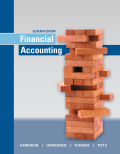
1. a.
To describe: The two competitors of Company K
1. b.
To describe: The Company K’s business nature and risk factors.
1. c.
To list: Three brands of Company K.
1. d.
To describe: The largest amount of assets and liabilities.
1. e.
To describe: Number of share authorized, issued and outstanding of Company K.
1. f.
To describe: Whether Company K repurchases any share of Common stock during fiscal year ended January 31, 2013.
1. g.
To describe: The timing of revenue recognition.
1. h.
To describe: The inventory method which is used by Company K.
1. i.
To describe: Whether Company K has any business interest in foreign countries.
2. a.
The
2. b.
The assets turnover ratio of Company K, evaluate the ratio.
2. c.
The return on assets of Company K, and evaluate the ratio.
2. d.
The leverage ratio of Company K, and evaluate the ratio.
2. e.
The return on equity ratio of Company K, and evaluate the ratio.
2. f.
The gross profit margin of Company K, and evaluate the ratio.
2. g.
The earning per share of Company K, and evaluate the ratio.
2. h.
The book value per share of Company K, and evaluate the ratio.
3. a.
The inventory turnover ratio of Company K, evaluate the ratio.
3. b.
The accounts payable turnover ratio of Company K, evaluate the ratio.
3. c.
The cash conversation cycle of Company K, and evaluate the ratio.
3. d.
The
3. e.
The quick ratio of Company K, and evaluate the ratio.
3. f.
The debt ratio of Company K, and evaluate the ratio.
3. g.
The time interest ratio of Company K, and evaluate the ratio.
4. a.
To describe: The two main sources of cash.
4. b.
To describe: Whether the net
4. c.
To list: The primary source of cash from investing activities.
4. d.
To list: The primary source of cash from investing activities.
4. e.
To analyze: The cash flow statement.
5. a.
To calculate: The common size percentage for sales, gross profit, operating income and net income for 2013 and 2014, and also comment about results.
5. b.
To calculate: The trend percentage of total revenue and net earnings and also comment about the results.
6. a.
To describe: The closing market price of Company K.
6. b.
To calculate: The price earnings ratio of Company K.
6. c.
To evaluate: Whether share of Company K is “buy, hold or sell” during the fiscal year.
Trending nowThis is a popular solution!

Chapter 13 Solutions
EBK FINANCIAL ACCOUNTING
- I am searching for the correct answer to this financial accounting problem with proper accounting rules.arrow_forwardCan you help me solve this financial accounting question using valid financial accounting techniques?arrow_forwardCan you solve this financial accounting problem with appropriate steps and explanations?arrow_forward
- How can I solve this financial accounting problem using the appropriate financial process?arrow_forwardDwight Industries estimates that overhead costs for the next year will be $3,250,000 for indirect labor and $475,000 for factory utilities. The company uses machine hours as its overhead allocation base. If 125,000 machine hours are planned for the next year, what is the company's plantwide overhead rate?arrow_forwardI need help with this general accounting question using the proper accounting approach.arrow_forward

 AccountingAccountingISBN:9781337272094Author:WARREN, Carl S., Reeve, James M., Duchac, Jonathan E.Publisher:Cengage Learning,
AccountingAccountingISBN:9781337272094Author:WARREN, Carl S., Reeve, James M., Duchac, Jonathan E.Publisher:Cengage Learning, Accounting Information SystemsAccountingISBN:9781337619202Author:Hall, James A.Publisher:Cengage Learning,
Accounting Information SystemsAccountingISBN:9781337619202Author:Hall, James A.Publisher:Cengage Learning, Horngren's Cost Accounting: A Managerial Emphasis...AccountingISBN:9780134475585Author:Srikant M. Datar, Madhav V. RajanPublisher:PEARSON
Horngren's Cost Accounting: A Managerial Emphasis...AccountingISBN:9780134475585Author:Srikant M. Datar, Madhav V. RajanPublisher:PEARSON Intermediate AccountingAccountingISBN:9781259722660Author:J. David Spiceland, Mark W. Nelson, Wayne M ThomasPublisher:McGraw-Hill Education
Intermediate AccountingAccountingISBN:9781259722660Author:J. David Spiceland, Mark W. Nelson, Wayne M ThomasPublisher:McGraw-Hill Education Financial and Managerial AccountingAccountingISBN:9781259726705Author:John J Wild, Ken W. Shaw, Barbara Chiappetta Fundamental Accounting PrinciplesPublisher:McGraw-Hill Education
Financial and Managerial AccountingAccountingISBN:9781259726705Author:John J Wild, Ken W. Shaw, Barbara Chiappetta Fundamental Accounting PrinciplesPublisher:McGraw-Hill Education





